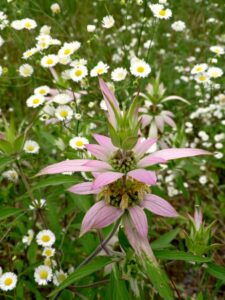Plant Profile: Monarda Punctata

Spotted beebalm is a guaranteed pollinator magnet. Add it to your garden or property and you will see pollinators—butterflies, bumblebees, honeybees, hummingbird moths, hummingbirds and others. While it’s a biennial or short-lived perennial, it readily self-seeds and naturalizes when the conditions match its needs.
The colors of this aromatic plant are unusual—lavender and white leaf-like bracts form whirls around the stem and under the light yellow tubular flowers, which are peppered with dark spots. Sometimes the flowers are white or green. Leaves have a minty scent and, like other beebalms, can be dried, crushed and steeped for tea.
This particular species is not as commonly grown in gardens as are wild bergamot (M. fistulosa), scarlet beebalm (M. didyma) and various cultivars, but spotted beebalm offers the benefit of being more drought-tolerant. Allowed to naturalize in a garden area, it forms swaths of “buzzing” blooms for about six weeks in late summer.
Spotted beebalm provides special value to native bees, bumblebees and honeybees, and it attracts predatory and parasitoid insects that prey on pest insects. Although not a host plant for the endangered Karner blue butterfly, it is a favored nectar source for that species. It is, however, a host plant for the gray marvel moth and the snout moth.
In addition to attracting pollinators, it provides excellent cut flowers, tolerates black walnut (Juglans nigra), and is deer- and rabbit-resistant. Added as a groundcover or a patch surrounding a vegetable garden, spotted beebalm will attract pollinators for other plants.
Using Monarda punctata in the Garden
Good companions for this plant include those that thrive in prairie settings and high-quality sandy habitats, and those that bloom or peak before, during and after it. The foliage merges well with other prairie plants. Examples include Rudbeckia hirta, Penstemon digitalis, Erigeron spp., Asclepias tuberosa and Symphyotrichum spp.
Spotted beebalm has somewhat unusual cultural preferences: sandy soils, sun to part shade, well-draining plots. The species is indigenous to sandy prairies, savannas, sand dunes and sandy fields. Plants often occur in disturbed or recently restored habitats; for example, it’s a great choice for reclaiming land from invasive plants like garlic mustard (Alliaria petiolata) or creeping bellflower (Campanula rapunculoides).
While it’s considered a short-lived perennial or a biennial, Monarda punctata, like others, can be reliably propagated by seed sown directly in the soil or in pots and transplanted to the garden. It can also be propagated by cuttings of young foliage.
Spotted beebalm will be equally at home in an open meadow, a naturalized area surrounding a formal garden or a small planting in a side garden. If you’re looking for ways to attract and benefit pollinators, this plant is a contender.
This article by Beth Stetenfield first appeared in the May/June 2020 edition of the Northern Gardener. She is a garden blogger and writer, and a master naturalist volunteer and instructor.
